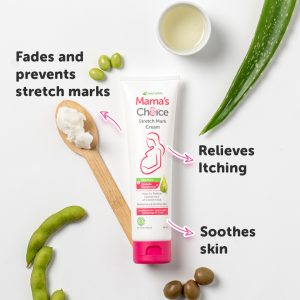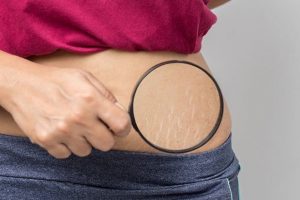Stretch marks during pregnancy are a common occurrence and mainly affect those whose skin contains less collagen. Are you struggling with the battle scars of pregnancy?
Stretch marks aren’t easy to deal with. To face this challenge, you’ll need a combination of taking care of yourself, as well as the right product to help you deal with stretch marks.
Read our guide to learn more about how you can deal with stretch marks during pregnancy!
What are stretch marks?
In order to deal with them, we need to understand what stretch marks are. Stretch marks occur when collagen ruptures in your skin. Collagen plays an important role in your skin’s elasticity, so a lack of collagen can cause your skin to get damaged as it stretches, resulting in stretch marks. They can appear on various parts of the body, such as the abdomen, thighs, hips, breasts, upper arms, and lower back. Stretch marks aren’t exclusive to pregnant women. Both women and men can experience it.
All about stretch marks
Before stretch marks appear, the skin will usually begin to look thin or pink. Stretch marks may initially seem like wrinkles, but slowly change colour and look different from other skin parts.
There are 2 main types of stretch marks:
- Striae Rubrae: Pink or red stretch marks
- Striae Albae: White stretch marks
Other types of stretch marks include:
- Stretch marks that occur due to pregnancy, better known as Striae Gravidarum
- Gray or black stretch marks which usually occur in people who have darker skin, called Striae Nigrae
- Dark blue/purplish stretch marks, also known as Striae Caerulea
- Stretch marks due to thinning skin. This can develop in those who suffer from Cushing’s syndrome (a collection of symptoms that arise due to high cortisol levels in the body). This type of stretch mark is also often referred to as Striae Atrophicans
Stretch marks causes and risk factors
Stretch marks are generally caused by:
- Pregnancy: 50-90% of mothers will experience stretch marks during pregnancy or after giving birth.
- Puberty: Due to the rapid growth that is common in teenagers
- Rapid weight growth: A dramatic increase or decrease in body weight can cause stretch marks.
- Medical conditions: Medical conditions such as Marfan syndrome and Cushing’s Syndrome
- Use of Corticosteroids: The frequent use of lotions and creams that contain corticosteroids can reduce collagen levels in the skin. Collagen strengthens and supports the skin, and can reduce the risk of stretch marks appearing.
Stretch marks can happen to anyone, especially pregnant women. It isn’t easy to avoid, but it’s possible with proper care. Now that you know what stretch marks are and what causes them, here are 6 important points you need to know to help deal with stretch marks!
1. Not all mothers experience stretch marks
During pregnancy, the skin on your belly stretches more and more. That’s why it’s important to moisturise your skin! Collagen can also help to thicken your skin, reducing the risk of stretch marks and helping to repair damaged skin.
Weight gain is also a big cause of stretch marks. The parts of the body that most often cause stretch marks are the abdomen, hips, thighs and buttocks.
Most pregnant women – around 50% – 90% – will experience stretch marks. Although the odds of avoiding stretch marks are slim, there are steps you can take to reduce the risk of them appearing!
2. Stretch marks can be caused by genes
Genes can affect the natural elasticity of everyone’s skin. For some, it will be nearly impossible to avoid stretch marks during pregnancy.
However, it’s possible to reduce the chance of stretch marks appearing by taking action during early pregnancy. Using a stretch mark cream or collagen-based product can also help to fade stretch marks if they appear!
3. Itchy skin can be a sign of stretch marks
Stretched skin is normally itchy. If you’re feeling itchy skin on your belly or thighs, you should take note of this! It’s probably a sign that stretch marks are about to appear. Instead of scratching, try relieving your itchy skin with safe moisturisers such as aloe vera.
(Tip: Our Mama’s Choice Stretch Mark cream moisturises your skin AND relieves itching! Find out more below.)
4. They don’t harm your foetus
Stretch marks can be really, really annoying to look at. Here’s a little bit of good news: They don’t harm your foetus at all!
Despite this, most of us would obviously prefer to avoid stretch marks. Read on below to learn how you can prevent them!
5. Stretch marks can be prevented

Actually, stretch marks can be prevented! There are 3 steps you need to take if you want to try and prevent stretch marks from appearing:
- Moisturise your skin regularly, especially vulnerable areas like your belly, hips and thighs.
- Avoid scratching your skin, as it can further damage your skin and worsen stretch marks.
- Use a collagen product to thicken or repair your skin, reducing the chance of stretch marks appearing or fading existing stretch marks.
We’ve actually developed a triple-acting Stretch Mark cream specially designed to help you with all 3 steps! Our Mama’s Choice Stretch Mark cream contains:
- Aloe Vera, which acts as the perfect natural moisturiser for your skin. It also relieves itching!
- Shea butter, which helps to protect your skin from damage.
- Lipobelle™ Soyaglycone, our hero ingredient! Lipobelle™ Soyaglycone is derived from soy, and naturally enhances collagen production in your skin, improving skin thickness by up to 12%. By increasing collagen production, Lipobelle™ Soyaglycone intensively protects your skin and fades existing stretch marks.
Pregnant mums need to keep an eye on any toxins they might be exposed to, which is why we’ve taken care to avoid all harmful ingredients in our Stretch Mark cream. It’s paraben-free, alcohol-free and dermatologically tested in Singapore! Check out the video below to find out why our stretch mark cream is trusted and loved by one of our many Mamas, Sari Yanti!
6. How to use stretch mark cream
You should use your stretch mark cream of choice every morning and night. Early intervention helps, which is why you should actually start applying your stretch mark cream regularly after the first trimester!
Fresher stretch marks (those which appear pink or purplish) are generally much easier to fade than established ones, which are white in colour.
If you’re using our Mama’s Choice Stretch Mark cream, you should apply it whenever your skin feels dry, or itchy! Our Stretch Mark cream is specially designed to help you relieve itching and build the collagen you need to prevent stretch marks (or fade existing ones).
Get yourself the solution to your stretch mark problems! Our stretch mark cream is currently available on Shopee and Lazada!
Mama's Choice MY
A mama of one hyperactive toddler, Michelle is adventurous, passionate about fitness, healthy eating and loves to garden in her free time.




















